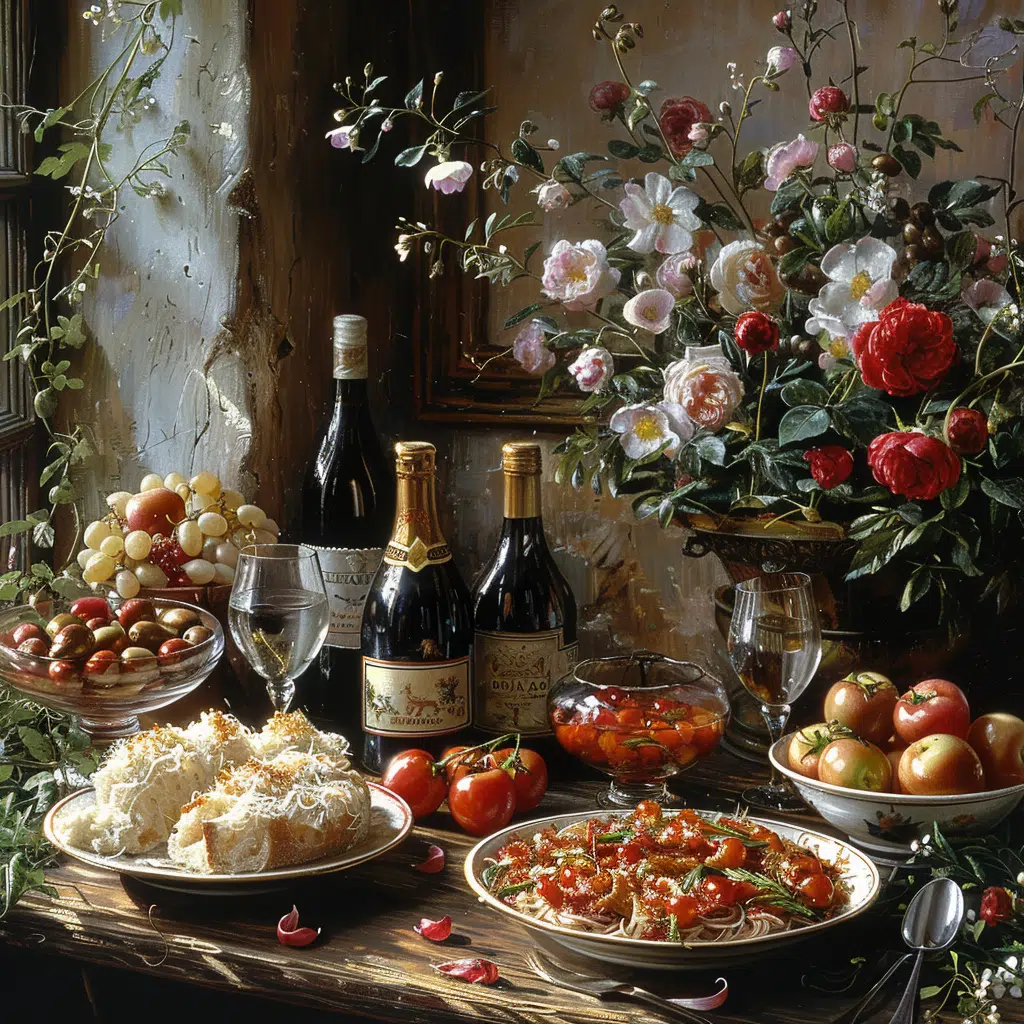Mangia’s Philosophy: Embarking on a Journey to Eat in Italian
In a world fast embracing the grab-and-go, Mangia offers an anchor back to the roots of Italian dining, where the term ‘eat in Italian’ is elevated from a simple act to a full-blown sensory affair. Like a heartfelt embrace from a long-lost friend, Mangia whispers, “Mangia! Mangia!” urging you to indulge with gusto. Here, the inherent warmth of the Italian table shines through, where to ‘mangia’ is not just to eat but to celebrate the joyous communion of good company and great food.
The ambiance at Mangia isn’t by accident. It’s carefully crafted to stroll you down an Italian strada; the walls echo with laughter, and the air is heavy with the aroma of garlic and fresh basil. Every corner, every dish, and every greeting is steeped in the essence of La Dolce Vita. Eating at Mangia isn’t a mere meal; it’s the chance to steal moments that linger as loving memories on the palate long after the table’s cleared.
Mangia opens its doors with more than a menu at hand. It’s an offer to sit down, slow the pace, and savor every bite in true Italian style. This place doesn’t just serve food; it serves up an experience that beckons patrons to embrace the joys of eating with every sense attuned.
The Gastronomic Tapestry: Exploring Authentic Italian Flavors at Mangia
Stepping into Mangia, one is instantly embraced by the aromas of simmering sauces and fresh herbs—tangible proof of the eatery’s reverence for authentic Italian cuisine. Here, a tapestry of flavors is woven with the skill of a master chef, creating dishes that are not only portraits of culinary excellence but also homages to Italy’s rich gastronomic heritage.
With a commitment to the land and its gifts, Mangia prides itself on its partnerships with local growers, ensuring that the peppers, tomatoes, and greens gracing your plate are as fresh as they come. Be it the sun-kissed zucchini or the perfectly aged Parmigiano-Reggiano, freshness is non-negotiable.
A taste of the hand-rolled pasta or slow-cooked ragù is a master class in the nuances that elevate Mangia’s offerings. The eatery takes pride in preserving time-honored techniques while crafting dishes that sing with innovative twists—think of it as a dance between traditional authenticity and contemporary creativity.
| Italian Phrase | Pronunciation | English Translation | Context/Usage |
| Mangia! | MAHN-ja | Eat! | An affectionate encouragement to start eating, often said by the host. |
| Mangiare | man-JA-re | To eat | The infinitive form of “to eat” in Italian. |
| Buon appetito! | bwon ah-peh-TEE-toh | Enjoy your meal! | A common phrase said before starting to eat, similar to “bon appétit” in French. |
| Ho fame | oh FAH-meh | I’m hungry | A simple statement expressing hunger. |
| Sono sazio/a | SO-no SA-tsyoh/ah | I’m full | Used to indicate that one has eaten enough. |
| Posso avere… | POH-so ah-VEH-re | ||
| A polite way to request something at the table, usually followed by the name of the dish or item desired. | |||
| Che cosa c’è di buono? | keh KOH-sah cheh dee BWOH-no | What’s good (to eat)? | A question typically asked when deciding what to order at a restaurant. |
| Vorrei… | vo-RAY | I would like… | Used to politely order food. |
| Il conto, per favore | eel KON-toh, per fa-VOH-re | The check, please | A polite way to ask for the bill at the end of the meal. |
| Una forchetta/piatto/bicchiere | OO-nah for-KEHT-tah/PEE-ah-toh/BEE-kye-reh | A fork/plate/glass | Requesting a piece of cutlery or dishware that is missing or needed. |
| Grazie | GRAH-tsyeh | Thank you | Always good to say after being served or helped. |
| Prego | PREH-go | You’re welcome | The response to “Grazie,” also used to say “please” in other contexts. |
Beyond the Plate: How Mangia Cultivates an Italian Dining Experience
Walk into Mangia, and you’re instantly transported. Every element, from the rustic table settings to the effervescent greetings — “Ciao bella!” — contributes to an all-encompassing Italian dining experience. The vibe is cozy, the décor reminiscent of a countryside trattoria, and the service, personable and as attentive as a nonna ensuring you’re well fed.
At Mangia, the notion of ‘eat in Italian’ extends to the layout of the tables, designed to beckon neighbors into convivial conversation. The clinking of glasses, the passing of platters, it’s all part of the show. Here, dining is not a solo pursuit; it’s collective jubilation over a shared love of food.
Anecdotes and laughter often spill from the kitchen as chefs share secrets of the trade. Patrons become part of the family, their stories weaving into the very fabric of Mangia. Here, every meal is a vibrant scene out of an Italian feast, where food and fellowship are inseparable.
Sipping in Style: Mangia’s Selection of Italian Wines and Aperitifs
To dine at Mangia is to understand that a meal is incomplete without the appropriate drink to kiss the edge of your glass. It’s why the curatorial excellence of their wine list is as critical as the menu itself. Selections from Tuscany, Piedmont, and beyond are not just beverages; they’re conversation starters, enhancers of the meal, companions to every bite.
Delight in the pre-dinner ritual of aperitivo, heartily embraced at Mangia. Whether it’s a crisp Prosecco or a bitter-sweet Negroni, the aperitif culture is there to whet your appetite and set the tone for the evening. And with a sommelier acting as your guide, even a novice can navigate the nuances of the Italian vine with confidence.
From Mangia to Your Kitchen: Cooking Classes and Culinary Sessions
Mangia doesn’t just believe in serving you outstanding Italian fare; it’s committed to empowering you to ‘eat in Italian’ within your own home. Through engaging cooking classes and hands-on culinary sessions, patrons are invited behind the scenes to toss pasta like the pros, season sauce to perfection, and master the delicate art of tiramisu.
The workshops are a deep dive into the heart of Italian cooking, offering skills that will turn your kitchen into a mini Mangia. Imagine recreating the perfect risotto, or perhaps the zesty lemon gelato you fell for one balmy evening at Mangia. As aprons tie and hands knead, the magic of Italian cooking comes alive, ready to be shared with loved ones back home.
Sustaining Traditions: Mangia’s Role in the Italian Culinary Community
Mangia isn’t an island but a vibrant node in the network of Italian culinary aficionados. It’s an active player in the local and global scene, stirring up excitement through participation in festivals that celebrate Italy’s rich food heritage. From showcasing its specialties at regional events to hosting lively gatherings that center around the joys of Italian cuisine, Mangia uplifts the spirit and the palate.
The eatery is dedicated to the cyclical growth of its community, fostering relationships that go beyond business. By supporting local producers and employing age-old cooking traditions, Mangia is more than a restaurant; it’s a hub, a nurturing ground for the seeds of Italian culture to flourish.
From Frequent Diners to Critics: What People Are Saying About Mangia
The chatter surrounding Mangia is just as flavorful as the dishes emerging from its kitchen. A tapestry of thoughts knit together by those who’ve had the pleasure of responding to the call to ‘eat in Italian’ within its walls. And the reviews? Well, they range from the raving “best Carbonara outside of Rome!” to accolades for the vibrant spirit that permeates every dinner service.
Culinary critics tip their hats to the relentless pursuit of excellence at Mangia—where every dish is an aria and the service, a well-orchestrated symphony. From blog posts that celebrate its innovative takes on classic desserts to features highlighting the immersive nature of the dining experience, Mangia revels in feedback that is as rich as a hearty Bolognese and takes every critique as an opportunity to reach even greater heights.
Sealing the Experience with Dolce: Mangia’s Dessert Innovations
Just when you think your adventure to ‘eat in Italian’ has reached its peak, Mangia reminds you there’s always room for dolce. The dessert menu offers both a nod to tradition and a wink to innovation, featuring everything from silky panna cotta to experimental gelatos that would make even the most rigid nonna smile.
The chefs at Mangia know that a meal is a narrative, and a robust finish is essential. Their desserts are composed of the highest-quality ingredients, each plate a work of art crafted to complement the crescendo of a meal well savored. And whether it’s a classic Tiramisu or a quirky Amaretto-flavored semifreddo, patrons leave with a sweet memento of their Italian escapade.
The Lasting Savor: Mangia’s Impact on the Fabric of Eat in Italian Culture
Mangia’s embrace of ‘eat in Italian’ dining doesn’t just end at its doorstep. It ripples outward, influencing how patrons perceive and engage with Italian cuisine globally. The eatery serves up a blueprint for others to follow, proving that dedication to tradition, coupled with a zest for innovation, is a recipe for timeless allure.
Pondering Mangia’s place in the future of Italian dining is like savoring a fine Brunello; it’s complex, richly textured, and promises to leave a legacy. As Mangia continues to weave its culinary spell, its impact on the Italian dining tableau seems destined to be as enduring as the very traditions it cherishes.
In the bustling realm of culinary exploration, Mangia stands as a beacon—a testament to the power of not just eating, but truly savoring the Italian way. It upholds the essence of Italian hospitality, urging you to linger, taste, and relish the journey. So, the next time the urge strikes to ‘eat in Italian,’ know that Mangia awaits with open arms and a table set just for you.
Let’s “Eat in Italian”: A Culinary Adventure
When you ponder the phrase “eat in Italian,” it summons visions of hearty pastas and pizzas, right? Well, turns out, Italians’ zest for food is just as eager when it comes to developing fresh flavors, akin to the unexpected yet delightful combinations found at Earth at Hidden pond. Picture this: an Italian chef, enamored with the local produce, decides to bring the vibrant vibes of Maine to traditional Italian dishes. Who would’ve thunk that Maine’s earthy essences could mingle so seamlessly with the spirited taste of Italia?
A Twist on Tradition
Speaking of unexpected pairings, did you know that Italian dinners might not always be paired with wine? Sometimes, a Rusty Nail is just the ticket. This cocktail, which can take the edge off like a good Brunello, makes for an intriguing dinner companion. Imagine an Italian nonna raising an eyebrow but then nodding in approval at the harmonious mix. And while the mash-up of Scotch and Drambuie is far from an Italian invention, it does mirror the Italian knack for blending bold personalities—you know, like those infamous Murdaugh family tree intrigues.
Modern Flavors Meet Timeless Techniques
Let’s jump from classic to contemporary, and no, we aren’t chatting about those Dunkin Donuts refreshers that are all the rage. Think more along the lines of Aigis from Persona 3—young, modern, but rooted in something timeless. Italian cuisine has this uncanny ability to evolve while remaining true to its soul. Just as Aigis balances the ancient with the new-age, Italian chefs are whipping up dishes that push the envelope while paying homage to the generations-old recipes handwritten in cursive, stained with drops of Chianti.
En Route to La Dolce Vita
Oh, and did you ever wonder how Italians stay so chic and fit given all the pasta chomping? Here’s a nifty tidbit: they view food as part of the journey to ‘la dolce vita’—the sweet life. Rather than scarfing down a meal faster than you can say Npc Tiktok girl, they take the slow lane, savoring every bite like it’s a moment frozen in time. Next time you’re cruising through Italian fare, give the ‘eat in Italian’ ritual a whirl, savoring your food like you would an engaging Apple Watch ultra review—meticulous, engaged, and ready to relish every feature (or flavor).
Leisurely Luxuries and Culinary Wanderlust
Ultimately, to “eat in Italian” doesn’t always mean staying within Italy’s borders; sometimes, it means bringing the essence of Italia to the rest of the world. Perhaps in a daring fusion restaurant nestled in one of El Salvador’s hotels, where the rhythmic waves dance to the same tune as jolly Italian laughter, merging two worlds into one. Eat slowly, embrace the joy of meals as if they’re scenes from a beautiful play, and always seek to add a dash of wanderlust to your plate. After all, that’s Italian dining—unhurried, full of surprises, and rich with history and affection. Buon appetito!
How do you say eat in Italian slang?
In Italian slang, you might hear “magna” instead of “mangiare” when referring to eating, especially in certain dialects or informal settings.
Does Mangia mean eat?
Yep, “mangia” pretty much means “eat” in Italian.
What is the Italian verb for to eat?
The Italian verb for “to eat” is “mangiare.”
How do you say food in Italy?
In Italy, “cibo” is the word for food.
How do Italians say good eating?
For good eating in Italian, someone may say “buon appetito,” wishing you a good appetite.
What does Mangia Tutti mean?
“Mangia tutti” translates to “eat all” or “everyone eats,” suggesting that a meal is to be shared with everyone present.
Why do Italians say Manja?
“Italians say “manja” (a version of “mangia”) as an affectionate way to invite friends and family to start eating, like saying “dig in” in English.
Why do Italians say Mangia?
Italians say “Mangia” to encourage guests to eat and enjoy the meal, showing hospitality and care.
What do Italians say before eating a meal?
Right before digging into a meal, Italians often say “Buon appetito,” which is like wishing everyone a good meal.
How do you say eat in Italian to a woman?
To tell a woman to eat in Italian, you’d still say “mangia,” as the imperative form doesn’t change with gender.
How do you say drink in Italy?
Bere” is the Italian word for “to drink.
What is the difference between Mangia and Mangio?
Mangia” is the informal, second-person singular imperative form of “mangiare,” meaning “eat!” while “mangio” is the first-person singular present indicative, meaning “I eat.
What is Bellissimo?
“Bellissimo” means “very beautiful” or “most beautiful” and is the masculine singular form of the word.
What do Italians say for pizza?
When referring to pizza, Italians use the word “pizza” itself – it’s the same in both English and Italian.
How do you say milk in Italy?
In Italy, the word for milk is “latte.”
What does Mangia Mia mean?
“Mangia mia” isn’t a standard Italian phrase, but if you see it, it might suggest a mix-up of words likely intended to mean “my eat” or “eat mine,” which doesn’t make much sense. It could be a playful way of saying “eat, my [loved one]” or possibly an error for “mangia, mia” (with a comma).
How do you say food in slang?
In English slang, “grub” is a common word for food.
What do Italians say when they like food?
When Italians enjoy their food, they might exclaim “Che buono!” or “È squisito!” to express how delicious it is.
What does Pica in Italian mean?
In Italian “pica” isn’t a widely recognized term, but it may be a misspelling or dialectal version of “picca,” which has various meanings depending on the context, none directly relating to food or taste. If you’re thinking of the Spanish word “pica,” meaning to bite or sting, in Italian, a similar word is “pizzicare.”
























